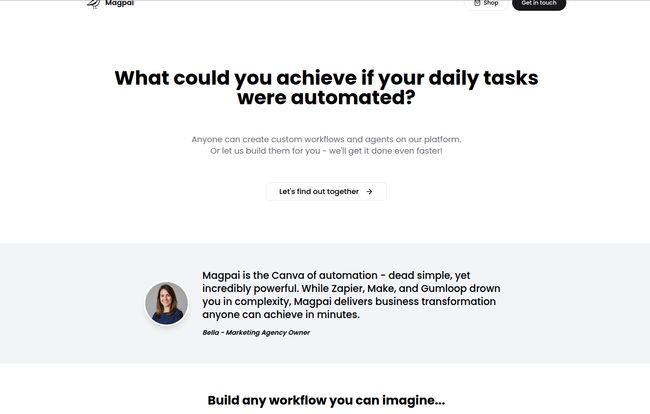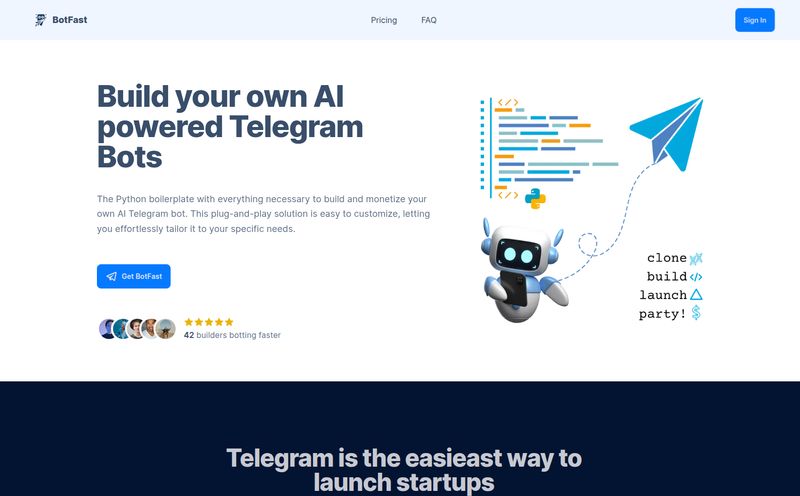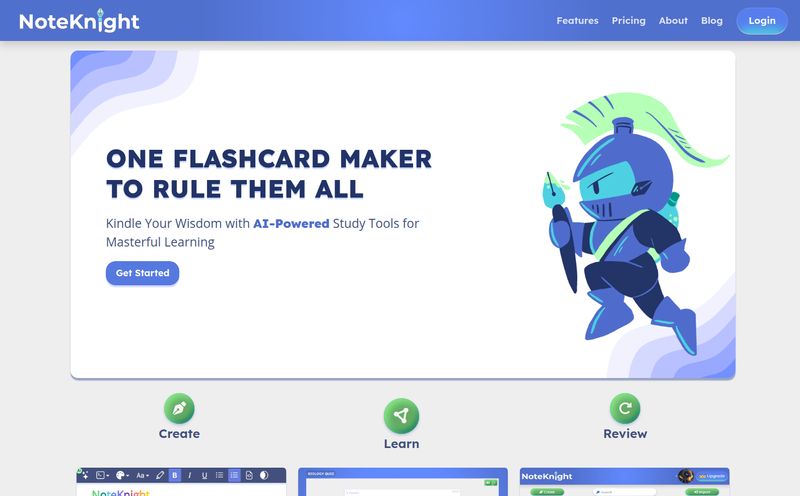If I have to manually export one more CSV file, copy-paste the data into a spreadsheet, and then draft three separate emails to tell three different people that the report is ready… I might just lose it. We live in an age of AI miracles, yet so much of our daily grind is still painfully, mind-numbingly manual. We've all been there.
So when a new tool pops up on my radar with the audacious claim of being “the Canva of automation,” my ears perk up. The tool is called Magpai. It’s a bold claim, right? Comparing yourself to Canva, the undisputed king of making complex design accessible to everyone, sets a pretty high bar. Canva made everyone a designer. Can Magpai make everyone an automation architect?
I’ve spent years in the trenches of SEO, CPC, and traffic gen, and I've seen countless tools promise to be the silver bullet for productivity. Some are great. Most are… not. So I decided to take a closer look and see if Magpai is the real deal or just another flash in the pan.
So, What Exactly Is Magpai, Anyway?
At first glance, you might think, “Oh, another Zapier or Make competitor.” And you’re not entirely wrong, but you’re not entirely right either. Magpai feels different. Instead of a linear, step-by-step “if this, then that” setup, it’s a visual, web-based platform. Think of it less like a to-do list and more like a digital whiteboard where you connect different apps and actions like you’re drawing a flowchart.
It uses a drag-and-drop system with what they call “nodes” – these are your apps, your AI models, your logic steps. You connect these nodes to build a “workflow.” So you can pull data from a Google Sheet, run it through an AI to summarize it, and then post that summary to a Slack channel, all by visually connecting the dots. It’s a much more intuitive way to think about complex processes, I think. It’s about building a central nervous system for your business operations, not just setting up simple alerts.

Visit Magpai
The Big Question: Who Is This For?
Magpai is clearly targeting a few specific crowds who are drowning in repetitive tasks. And honestly, they've picked their battles well. These are the folks who feel the pain of manual processes most acutely.
For Marketing Agencies
If you run an agency, you know the struggle. Onboarding new clients, pulling monthly performance reports, managing ad spend alerts… it’s a constant juggle. Magpai pitches the ability to automate client reporting and even build custom agents to handle initial new client queries. Imagine an AI that not only answers a prospect's basic questions but does so following your agency’s exact brand playbook. That’s a serious time-saver.
For E-commerce and Shopify Stores
Ecomerce is a game of margins and efficiency. Magpai talks about automating things like SEO optimization for product listings or powering smarter customer support chatbots. The ability to connect directly to Shopify and other platforms means you could, for example, create a workflow that identifies a high-value customer and automatically sends them a personalized thank you SMS. Pretty slick.
For SaaS & Software Companies
User onboarding is everything in SaaS. A good experience keeps users, a bad one sends them running. Magpai suggests you can build automated workflows to guide new users, analyze product usage data to identify at-risk customers, and even white-label AI services built on their platform into your own product. That last one is a particularly interesting angle.
For the Unsung Heroes: Operations Managers
Ops managers are the glue that holds a company together. They deal with the cross-departmental chaos. Magpai aims to help them automate performance monitoring, streamline internal processes, and ensure everyone is on the same page without a million meetings. This is where that visual workflow builder really shines, because you can literally map out how information should flow through the company.
Getting Your Hands Dirty: DIY vs. Done-For-You
Magpai offers two ways to get started, which I think is a smart move. You’ve got:
- Option 1: Do It Yourself. This is the classic SaaS model. You request early access, get into the platform, and start building. They provide pre-built templates for common tasks, and the whole point is that you don’t need a developer. You can just start connecting those digital Lego blocks yourself.
- Option 2: We Build For You. This is their white-glove service. You book a consultation, tell them your problems, and their team designs and builds the custom automation solution for you. It's basically an agency model for their own tool.
Personally, I'm always a fan of the DIY approach. That's where you truly learn the power of a tool. But for a slammed founder or a non-technical team that just needs a problem solved yesterday, the “We Build For You” option is a fantastic escape hatch.
What I Like and What Makes It Different
After poking around, a few things really stand out. First, the visual, drag-and-drop workflow is a game-changer. It just makes more sense for a human brain, especially for complex, multi-step processes. It’s less intimidating than a wall of configuration options.
The second thing is the focus on creating AI agents with a consistent brand voice. This is huge. So many companies are plugging in generic chatbots that sound, well, robotic. The ability to bake your brand guidelines, your tone, your specific turns-of-phrase into your automations is a massive step up. It's the difference between a helpful tool and an extension of your brand.
And of course, the integrations. They seem to connect with all the usual suspects: Slack, Google Drive, Notion, Shopify, AWS, and a whole lot more. An automation tool is only as good as the other tools it can talk to, and Magpai seems to be pretty chatty.
The Elephant in the Room: Let’s Talk About Pricing
Okay, here’s the rub. If you go looking for a pricing page on Magpai’s website… you won’t find one. In fact, when I tried, I hit a 404 “Not Found” page. Ouch.
Now, some might see this as a red flag. And it is a bit annoying. But in my experience, this is a pretty common strategy for B2B SaaS platforms in this stage. They want you to book a demo or a consultation. Why? It allows them to qualify leads, understand your specific needs, and propose a price that matches the value you’ll get. It prevents sticker shock and lets them have a conversation first. Is it my favorite approach? No. I like transparent pricing. But I get it. Just be prepared to have a conversation rather than just swiping a credit card.
Is Magpai the Perfect Automation Solution?
Look, no tool is perfect. Magpai is really compelling, but it’s not without its potential downsides. The no-code interface is brilliant for getting started, but I suspect that to build the really sophisticated, multi-layered agents they show off, there’s going to be a learning curve. That’s not a bad thing—powerful tools should have depth—but it's something to be aware of. It's not a toy. Also, its power is tied to its cloud-based nature. That means you’re relying on their servers to be up and running for your critical business processes to work, which is standard for SaaS but always a point to consider.
So, is it just another automation tool? I don't think so. I’d place it in a fascinating middle ground. It's more powerful and flexible than a simple IFTTT or Zapier, but it stops short of requiring you to hire a full-on developer to write custom scripts. It's aiming for that sweet spot of powerful and accessible.
My Final Verdict
So, does Magpai live up to the “Canva of automation” hype? It just might. The philosophy is absolutely there: take something complex (automation architecture) and make it visual, intuitive, and accessible. It’s an ambitious project, and from what I can see, it has a ton of potential for agencies, ecom stores, and any business tired of being bogged down by manual tasks.
The lack of public pricing is a hurdle, but if the pain of your repetitive work is high enough, booking a call to investigate further is probably a worthwhile investment of your time.
Frequently Asked Questions about Magpai
- Do I need to know how to code to use Magpai?
- Nope! The platform is built around a visual, no-code, drag-and-drop interface. The whole point is to empower non-technical users to build powerful automations.
- What kinds of tools can Magpai integrate with?
- It connects with a wide range of popular business tools, including Slack, Notion, Google Drive, Shopify, various CRMs, and even cloud services like AWS.
- Is Magpai good for a solo freelancer or just big teams?
- It seems designed to scale. A solo freelancer could definitely automate their own reporting and client management, while a larger team could use the collaborative features to design company-wide operational workflows.
- How is Magpai different from Zapier or Make?
- The main difference is the approach. While Zapier and Make often use a linear, trigger-and-action list format, Magpai uses a visual, node-based canvas. This can make it easier to design and understand more complex, multi-path automations. It also has a stronger focus on building AI agents with specific brand personalities.
- Where can I find Magpai's pricing?
- As of now, Magpai does not have a public pricing page. To get pricing information, you need to book a consultation or a demo through their website.
- Can I really build a custom AI agent for my brand?
- Yes, this is one of its core features. You can customize AI agents with your specific brand guidelines, ensuring that any automated communication aligns with your company's tone and voice.
Conclusion
In a world overflowing with apps that promise to simplify our lives, Magpai feels like it’s actually trying to solve a foundational problem. It’s not just about connecting two apps; it’s about redesigning how work flows through your business. If they can nail the execution and build a strong community, Magpai could very well become a go-to tool in the modern business stack. It’s definitely one to watch.



